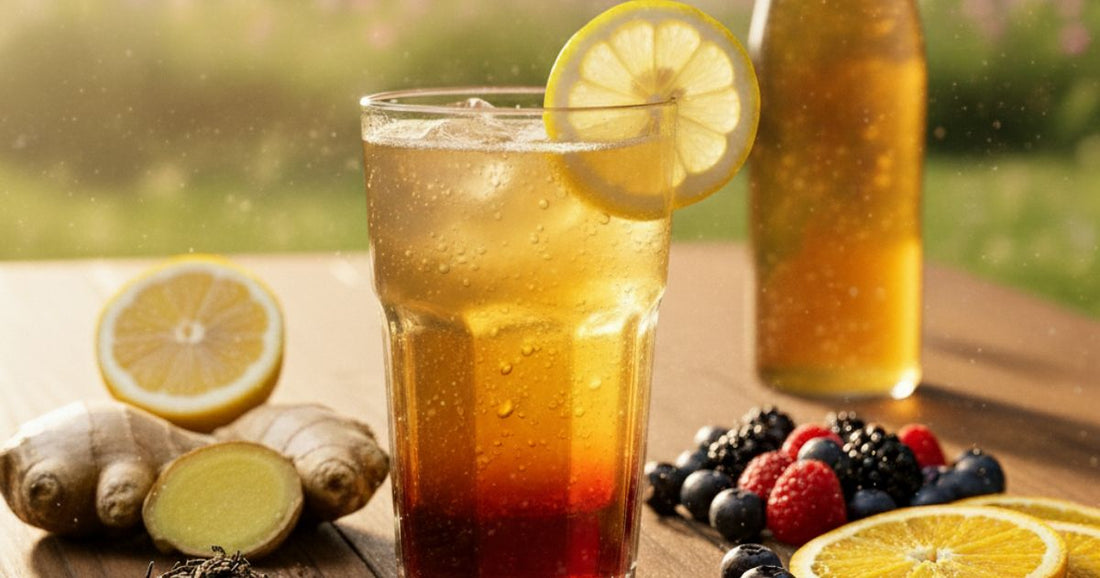
10 Common Kombucha Myths Explained (and Why It Fits a Healthy Routine)
Share
Kombucha can absolutely fit into a healthy routine: it’s a naturally fermented tea that brings live cultures, tea antioxidants, and a refreshing, lower-sugar swap for soda.
The science is still growing, so the smartest approach is realistic claims + good habits (labels, portions, and hygiene for home brewers).
Naturally sweet, creamy Georgia Peach Kombucha never disappoints. Shop here.
1) “Kombucha will get you drunk.”
Reality: Commercial kombucha in the U.S. must remain under 0.5% ABV; that’s the same threshold used for “non-alcoholic” drinks. Home brews can creep higher if they over-ferment, so monitor if you’re doing a DIY version.
2) “It’s a miracle detox.”
Reality: Kombucha provides organic acids and live microbes, but there are few high-quality clinical trials proving disease-treatment claims. Think of it as a functional beverage that complements—not replaces—sleep, movement, fiber, and diverse whole foods.
3) “All the sugar ferments away.”
Reality: Residual sugar remains and varies by brand. Recent analyses report ~0.2–6 g per 100 mL in commercial bottles—enough to check labels if you’re watching carbs. Choosing lower-sugar flavors makes kombucha an easy upgrade from soda.
4) “Kombucha is caffeine-free.”
Reality: It starts as tea, so most bottles contain a small amount (typically well below coffee or brewed tea). If you’re sensitive, scan labels and sip earlier in the day.
Shop the full line of Firewalker Beverages Kombucha. Click here.
5) “Any amount is safe for everyone.”
Reality: Sensible portions matter with any acidic, live-culture drink. A practical rule from clinicians: start around 4 oz (118 mL) per day, then work up (many healthy adults land at 8–12 oz). Pregnant or immunocompromised? Choose pasteurized options or ask your clinician first.
6) “More sour = more probiotics.”
Reality: Tartness reflects acidity (low pH), not probiotic count. Very acidic drinks can soften tooth enamel faster than cola in lab tests—simple fix: drink in one sitting with food, then rinse with water.
7) “Every bottle has the same microbes.”
Reality: Microbial profiles differ by brand and recipe. That’s normal for fermented foods, and variety is part of the appeal. It also means effects can vary person-to-person, so focus on how you feel while keeping the rest of your diet fiber-rich.
Want to flavor your own kombucha? Use mouthwateringly sweet and tart Blackberry Sangria. It fits the bill and is a consistent customer favorite. Buy now.
8) “Kombucha guarantees weight loss.”
Reality: One small 2023 human pilot in people with diabetes linked kombucha with lower fasting glucose, which is promising but preliminary. Healthy weight management still comes from overall dietary pattern and activity.
9) “Home-brewed kombucha is always safe.”
Reality: Most home batches are fine when equipment is sanitized and vessels are food-safe. But poor hygiene and risky containers (lead-glazed ceramic) have been linked to illness—use clean glass/stainless and good brewing practices.
10) “Kombucha isn’t healthy.”
Reality: When you pick low-sugar options and reasonable portions, kombucha is a tasty, practical way to add live cultures and tea polyphenols to your week—an upgrade in any beverage lineup. It shines as part of a balanced lifestyle built on plants, fiber, movement, and sleep.
How to Make Kombucha a Healthy Habit
-
Scan the label: Aim for ≤ 6–8 g sugar per serving; confirm < 0.5% ABV on commercial bottles.
-
Start modestly: 4 oz is a great beginning; many settle at 8–12 oz/day.
-
Pair with meals: This helps buffer acidity and supports oral health alongside normal brushing/rinsing.
-
Home-brew safely: Sanitize tools, use glass or stainless, and avoid lead-glazed ceramic.
Sources
-
Mayo Clinic – “Kombucha tea: Does it have health benefits?” Mayo Clinic
-
Cleveland Clinic – “What Are Kombucha’s Health Benefits (and How Much Can You Safely Drink)?” Cleveland Clinic
-
CDC MMWR (1995) – “Unexplained Severe Illness Possibly Associated with Consumption of Kombucha Tea — Iowa” CDC
-
Frontiers in Nutrition / PMC (2023) – “Kombucha tea as an anti-hyperglycemic agent in humans” (pilot RCT) PMC
-
Acta Odontologica Scandinavica (2023) – “Erosive potential of ice tea beverages and kombuchas” PubMed
-
U.S. TTB – “Kombucha and Alcohol Compliance (≤ 0.5% ABV threshold)” Alcohol and Tobacco Tax and Trade Bureau
-
MDPI Foods (2024) – “Kombucha: An Interesting Reservoir of Microbial Diversity” (includes commercial sugar ranges) MDPI
- Healthline – “Does Kombucha Tea Contain Alcohol?” (consumer explainer referencing the 0.5% rule) Healthline
